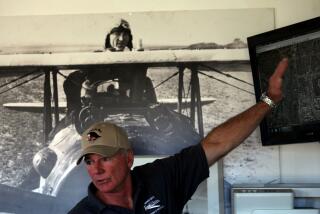Pilot’s Comrades Plan Final Tribute in Military Style
- Share via
His friends in the Condor Squadron who fly World War II planes as a hobby and a way of life said Sunday that they hope to stage a military-style “missing man” funeral at Van Nuys Airport for Merrel Gossman of Canoga Park, who died Saturday when his vintage trainer crashed in Orange County.
In another tribute, skywriting planes appeared Sunday over the San Fernando Valley and El Toro Marine Corps Air Station, where Gossman was killed, and wrote across the sky, “We Salute Gossman.”
Gossman, 55, a one-legged pilot who once wanted to be a Roman Catholic priest, died when his AT-6 plummeted into the empty chapel at El Toro and burst into flames.
Also killed was a passenger, Robert G. Arrowsmith, 25, a Navy hospitalman stationed at El Toro.
Awaiting Approval
The Condor Squadron, made up mostly of former military pilots, was at the Marine Corps station Saturday to stage a mock air battle as part of an air show when the accident happened.
The club is waiting for approval from Gossman’s widow and the management of Van Nuys Airport before going ahead with plans for a ceremony Saturday at their clubhouse alongside the airport’s runway, said the club’s founder, Richard T. Sykes, a Toluca Lake lawyer.
“We want to have the whole thing--an awning on the lawn, a chaplain to read the service and a missing man flyby by all 11 of our planes,” Sykes said.
The “missing man” is a traditional salute to a military pilot, in which a group of planes roars low overhead during the service. One plane banks away, leaving a space in the formation to represent the absence of the fallen pilot.
Wanted to Carry On
Sykes said the Condors wanted to carry on with the air show at El Toro after the accident but the Marine Corps refused, “apparently because they thought we’d be too broken up or something to fly.”
The Condors instead flew to Shafter, north of Bakersfield, where they performed Sunday in an air show at Minter Field, “because that’s what you’re supposed to do, carry on,” Sykes said. “When we make commitments, we carry them out.”
The Condors range in age from their mid-40s to early 70s. About half flew fighter planes in World War II; other members served in Korea or Vietnam. The group’s clubhouse has been decorated to resemble the officers’ club on a World War II fighter base in England. They park their AT-6 planes outside--half painted in American colors and half with German markings for the mock air battles the group stages at air shows and private dogfights members hold to amuse themselves.
Gossman, a floor-covering contractor, was regarded as an excellent pilot, Sykes said. His plane apparently stalled just after takeoff for reasons that were still unknown Sunday, Sykes said.
Gossman, a man with a dry, deadpan sense of humor, left behind some mysteries about his past. Although he told some interviewers that he was a former Marine Corps pilot, “I’m pretty sure that wasn’t true,” Sykes said. “He learned to fly as a civilian after he got out of the service.”
Gossman’s plane was modified for him to fly with an artificial leg. He had lost his right leg below the knee, and apparently gave more than one explanation of how it happened.
“He told me he was a Marine during the Korean War and stepped on a land mine,” Sykes said.
Nick Beck of Sherman Oaks, who met Gossman at Los Angeles City College in 1955 when both were journalism students, said Gossman told him he had accidentally shot himself in the leg, “in a hunting accident or something like that.”
Beck said Gossman said that the loss of the leg had forced him to leave a seminary.
More to Read
Sign up for Essential California
The most important California stories and recommendations in your inbox every morning.
You may occasionally receive promotional content from the Los Angeles Times.









